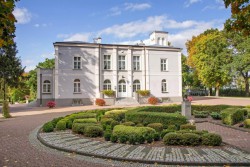- About Chopin Centre
- About Szafarnia
Years 1988 – 2004
After the renovation which lasted 8 years, on 10 September in the presence of the local authorities, an official opening of The F. Chopin Cultural Centre took place ; the opening ceremony was accompanied by a recital by Ewa Pobłocka and also by the reading of Szafarnia Courier by Igor Śmiałowski. The Centre obtained some new pieces of equipment, a Petrof grand piano among other things. At that time the Centre occupied four rooms at the ground floor of the building (a concert room, a museum room, a lounge and a hall). The first floor of the building belonged to the primary School in Szafarnia. The park surrounding the building was also being developed gradually.
The first person to become the director of the newly-refurbished building was Hanna Kończalska. The Centre’s most important preoccupation was organizing concerts of Polish as well as foreign artists (mainly piano recitals).
In 1990 Elżbieta Buler became the new director of the place. She continued her work up till October 2008. During that time she initiated many projects which are still present in the calendar of events organized by the Chopin Centre in Szafarnia. The most important of the aforementioned events is The Fryderyk Chopin International Piano Competition for children and youth. The first competition took place in 1992.
In the period between 2002 – 2003 there was a strike in Szfarnia organized by the parents of the children who attended the school which took up the first floor of the Dziewanowskis estate. The parents opposed to the decision of Radomin Commune Council concerning the closing of the school. During that time, the Centre’s activity was suspended for the second time.
Years 2004 – 2009
In February 2004, Sejmik of the Kujawsko-Pomorskie Voivodeship adopted a resolution regarding cooperation with Radomin Commune in the running of the New Chopin Centre, commencing on 1 September 2004. This institution took over all the remaining rooms occupied by the Primary School which had been closed.
On 5 January2009, dr Agnieszka Brzezińska became the new director of the Centre. Some of her main aims are promoting the place among Polish and foreign tourists, broadening the offer aimed at children and youth and also transforming the museum room into an interactive gallery. Apart from the aforementioned plans, the Centre maintains its concert and educational activity on a regular basis.
At the moment the Centre is preparing for the Chopin Year 2010 celebrations. Among its numerous investments, the Centre is the purchase of a new grand piano for which the Chopin Centre has already collected the money from the Ministry.
This friendship grew deeper because Dominik Dziewanowski (Juliusz’s son) and Fryderyk Chopin became friends and also due to the fact that Jan Nepomucen Dziewanowski became Ludwika Chopin’s godfather. The bond between Domuś and Frycek became even stronger during the period when the two studied together in the High School in Warsaw. This led to the two visits the young composer paid at the Dziewanowskis estate in the summers of 1824 and 1825. However, his stay was not only limited to social meetings and events. It proved to have had a great influence on the formation of artistic sensitivity in the author of piano masterpieces. It was nowhere else but in Szafarnia, where Chopin came in contact with authentic folk music, the elements of which can be found in his numerous works. His unique national style can also be attributed to this experience. What is more, many scientists claim that the mazurkas which were inspired by folk music, and which were played during young Chopin’s stay at the Dziewanowskis manor, became the models for the composer’s later masterpieces. It is assumed that during that time the original version of Mazurka a minor op.17, No. 4 called The Jew was written.
Details of the young composer’s stay in Szafarnia can be easily reconstructed thanks to the letters he sent to his parents in Warsaw. The messages sent in the so called Szafarnia Courier, which bore a great resemblance to Warsaw Courier, present a substantial value. These used to describe national events (concerning Szafarnia itself) as well as the international ones (regarding neighbouring villages) in a very witty and amusing way. The aforementioned documents not only prove that the young composer actually stayed in the area, but also show us his character and temper. These documents portray him as a teenage boy whose interests focused not only on music and culture of the region, but also on the local society, its female part in particular.
The visits of the great composer made Szfarnia an important place on the music scene. His stay at Dobrzyń Land initiated a number of cultural activities the aim of which is to propagate and popularize the music of this excellent Polish composer.
Szafarnia has always encouraged numbers of people to come and visit this beautiful part of Dobrzyń Land. In the place of the former Dziewanowskis larch manor, there is an eclectic building, dating back to the end of the XIX century, which is the house of the Chopin Centre – a place of numerous cultural events. It is surrounded by a marvelous park in which one can wander among the trees which have been growing there since the times of young Chopin’s visits. ( Among park’s nature monuments there are some which are particularly interesting, namely Chopin’s lime tree and Dziewanowski Oaks.
Famous Poles connected with Szafarnia |
|
Fryderyk Chopin (1810-1849), great Polish composer and pianist. During his lifetime he visited Szafarnia twice while on summer holidays at the Dziewanowskis family estate. These experiences are said to have influenced his work and artistic imagination to a great extent. Dominik Dziewanowski (1759 – 1827) was an adjutant in the army of S. Poniatowski . In 1806 he entered the military service. He received The Honorable Legia and Cavalier Cross of Polish military order. Jan Nepomucen Dziewanowski (1782-1808), a well-known officer of the light cavalry who died after the charge on Somosierra. There is an obelisk in memory of this war hero at the cemetery near a church in Płonne. Before his death he was given a medal by Napoleon himself.
|
Bibliography |
|









